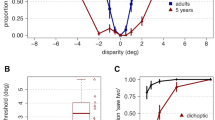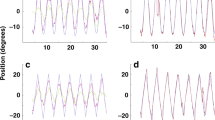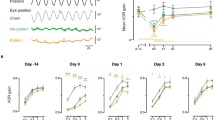Abstract.
The development of visual and vestibular control of smooth gaze adjustments was studied longitudinally in 3- to 18-week-old infants. Eye and head movements were measured with electro-oculography (EOG) and an optoelectronic system, respectively. The infant was placed in a chair providing full support to the trunk but allowing relatively free head movements. The chair was positioned at the center of a striped-patterned drum. The chair and the drum were oscillated sinusoidally, either individually or in synchrony at 0.25 Hz. When the drum oscillated around the infant (the optokinetic response condition, OKR), the gain of both smooth eye and head tracking components was low up to 6 weeks of age, after which the eye gain increased dramatically and the lag decreased. The most substantial increase in head gain was observed at 13–18 weeks of age. When only the chair was oscillated (visual VOR, VVOR), the compensatory eye gain was high at 3 weeks and the head contributed significantly to the compensation (vestibulocollic reflex, VCR). The head gain increased significantly at 13–18 weeks of age as in the OKR case. When the drum and the chair were oscillated synchronously (inhibition of VOR, VORINHIB), the compensatory eye gain was significantly lower than in the VVOR, indicating suppression of VOR. This effect was considerable at 3 weeks. However, VCR was not suppressed but comparable to the VVOR condition at all ages studied. In summary, we found that the vestibular control of smooth gaze adjustment functions earlier than the visual control. At 2 months, the visual control improves dramatically and at 3–4 months head participation increases considerably. The eye gain in the VORINHIB condition could be well predicted by vector addition of the eye position signals in the OKR and VVOR conditions.
Similar content being viewed by others
Author information
Authors and Affiliations
Additional information
Electronic Publication
Rights and permissions
About this article
Cite this article
Rosander, K., von Hofsten, C. Visual-vestibular interaction in early infancy. Exp Brain Res 133, 321–333 (2000). https://doi.org/10.1007/s002210000413
Received:
Accepted:
Issue Date:
DOI: https://doi.org/10.1007/s002210000413




